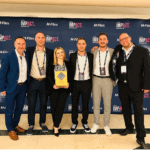
Customer Success in M-Files Implementations – Best Practices
Your business exists to serve your customers, right? So you need to make sure you are doing all you can to keep the customer happy and satisfied with the solution you provide them with. That’s the job of customer success.
What is Customer Success?
When software products turned to the subscription model, it gave software companies a more predictable revenue, which they can use to further improve their products. However, customers are now able to cancel subscription at any point, which prompted companies to ensure their customers get the best value from using their product and the best customer experience they can.
That’s why customer success (CS) is imperative in today’s business. Great CS practices lead to satisfied customers who believe in the provided solution that helps them achieve their business goals.
On the other hand, customer success creates partnerships, growth opportunities for the company and customer advocates.
So, how can you achieve that?
Here, we’ll show you our customer success approach that got us the recognition as the M-Files Customer Success Partner of the Year. We’ll give you actionable steps you can do to help your customers and reap the benefits of customer success.
Anticipate customer needs and fulfil them through your solution
M-Files defines their customer success practices with a sentence:
We succeed together by forging deep, trusted relationships with customers while also exploring new ways to optimize their document management process.
Customer success is the actions a company does to anticipate customers’ needs and fulfil them through their solutions and products.
Customer success should result in customers wanting to continue using the service or product a company provides in the long term.
How we implement customer success practices in Unitfly
Our slogan is People, Business, Technology and Innovation – we take pride in being a people-centric company. That means that our main focus is our people, our teammates, as well as our customers.
First and foremost, customer success is about defining the value of the solution we provide together with the customer – what the customer’s challenges are, how we can help them overcome them and improve their business using our solution.
Every method we use to deliver the best value we can to our customers is about communication – understanding the needs, communicating the value and managing the expectations.
Essentially, we consider ourselves long-term advisors who want to help our customers improve their business gradually and completely.
Here are the main elements of our customer success practices that drive value:
- Customer account profile
- Joint success plan
- Regular check-ins
- Executive business review (EBR)
- Surveys
1. Customer account profile
Jay Baer, the president of Convince and Convert, an online customer service and digital marketing consultancy said: “The more you know about your customers, the more you can provide to them information that is increasingly useful, relevant and persuasive.”.
The first thing our consultants do is create a customer account profile, to get the complete picture of customer’s needs and wants. It is a document that is the ground for building a successful implementation strategy, as well as a means to track the customer’s progress throughout the project.
It is important to periodically write down information about the customer’s situation and expectations of the project. It’s easy to lose direction when you’re not reviewing the needs and benefits the client expects. Using the customer account profile you can evaluate the success of the project, and make sure to deliver the value your customer anticipates.
2. Joint success plan
In order for the customer to be satisfied with the solution, the project has to be successful.
First we need to, together with the customer, identify what “success” is for them and how we can achieve that.
Joint success plan is a document, written in collaboration with the customer, that lays out their current situation, their challenges and pain points, identifies their business objectives and action plans of how we can help them get there. All in all, joint success plan details the path toward achieving business outcomes that is a reference point for both your customer and for you.
3. Regular check-ins
Every check-in you do with your customer should be intentional and deliver value to you and to them. It is not a matter of asking how everything is going, but evaluating the progress and working toward the goals and expectations of the client.
Regularly asking for feedback during implementations will ensure that the solution is tailored to their wants and finished on time.
Find out if the adoption of the solution is going well, if there are some concerns regarding the solution, discuss the progress and potential issues. It’s better to anticipate the problem than to react retroactively.
4. Executive business review
Executive business review (EBR) is a formal meeting we conduct with our customers quarterly. The primary goal of EBRs is to create a space for the customer to communicate their concerns, expectations and ideas.
Our job is to present progress, the value the solution brings, and plan the next steps and discuss what else we can do to improve their business. That’s a great way to remind them of the improvements the solution brings.
Communicate the purpose of the meeting and the prerequisites, and schedule the meeting well ahead.
5. Surveys
In order to deliver great customer service, we must evaluate it regularly. Surveys are a great way to learn about the strengths and weaknesses of our approach, and to recognize what needs to be improved.
After each project, we send the surveys to the customer and adopters, analyze the results and act accordingly.
Regular communication is key
The bottom line?
Your solution and approach to customers must deliver value to their business.
The processes introduced above give you the technique to understand your customers better, to listen and learn about their needs and goals. The insights you get from these practices will give you the means to anticipate customers’ requests and provide the solution they need.
By following customer success practices at your company and supporting your clients throughout your collaboration, you ensure they become loyal advocates and spread the word about your brand.



